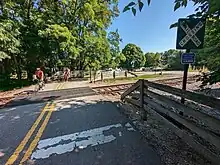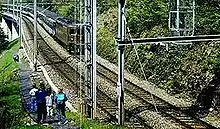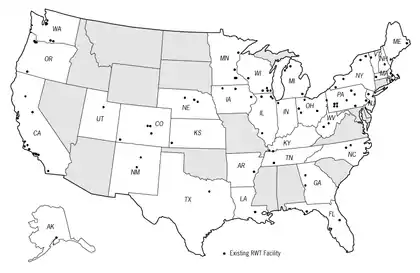Rails with trails
Rails with trails (RWT) are a small subset of rail trails in which a railway right-of-way remains in use by trains yet also has a parallel recreational trail. Hundreds of kilometers of RWTs exist in Canada, Europe, the United States, Australia, and the United Arab Emirates.[2][3]

Australia
Rails with trails in Australia usually exist along publicly owned passenger railways outside of the larger cities. They are called "rail-side trails" and are built on railroad-owned land but managed by local government entities.[2]
Canada
Rails with trails exist in most provinces including Nova Scotia, Québec, Ontario, Saskatchewan, Alberta, and British Columbia.[2] While the length varies, most are relatively short compared to those in the United States, ranging from less than 100 meters long to several kilometers. Canadian rails with trails are frequently smaller segments of a longer trail, "with a rails-with-trails portion located on bridges, at choke points, and where the rail corridor was deemed the best alignment for a portion of a trail."[2]
Europe

Some urban bike paths in the Netherlands feature bicycle trails and tracks for trams located side-by-side. And in England and Switzerland, there are also rural routes where intercity trains run parallel to multiuse trails.[2]
United Arab Emirates
While the United Arab Emirates does not have a large number of railroads, rails with trails do exist along rail transit corridors.[2] The Roads and Transport Authority maintains a nine-kilometer bicycle trail alongside the Dubai Tramway that connects stations with Jumeirah Beach and various residential areas.[2]
United States
In 2000, there were 1,000 rail trails in operation nationwide, comprising a total length of about 17,750 km /11,029 mi. Only 60 (387 km/240 mi) were rails with trails, up from 37 (246 km/152 mi) in 1996.[4] Thus, on average United States rail trails in 2000 were 11 miles (18 km) long with a small minority of rails with trails being 4 miles (6.4 km) long.
As of 2018, there were 343 identified rails with trails in the United States, comprising 917 miles of rails-with-trails in 47 states.[5] By comparison, there are currently 2,404 open rail-trails across the United States comprising a total of 25,723 miles along with 867 rail-trail projects planned for an additional total of 9,147 miles.[6]

United States rails with trails with articles on Wikipedia:
Safety

Rails with trails are considered safe, with a 2013 report from the Rails-to-Trails Conservancy finding only one record of a fatality involving a rail-with-trail user and a train, and just two reports of injury, during a 20-year period in the United States.[7]
A 1997 study of the feasibility of rails with trails identified a need for guidelines concerning RWT crossings, fencing, setbacks, and other items. These guidelines were developed in the form of Rails-with-Trails: Lessons Learned,[8] which finds that "well-designed RWTs meet the operational needs of railroads, often providing benefits in the form of reduced trespassing and dumping. A poorly designed RWT will compromise safety and function for both trail users and the railroad."[9]
A 1996 study of safety on rails with trails in the United States evaluated 37 existing RWTs in 16 states and concluded that "active railroad lines can function with an adjacent pedestrian, horse, and bike path without problem" and RWTs are "no more dangerous than rail-trails alone or next to busy streets."[10]
References
- America's Rails-with-Trails Report: A Resource for Planners, Agencies and Advocates on Trails Along Active Railroad Corridors by Kelly Pack, Rails-to-Trails Conservancy, 2013, page 25.
- FRA 2021, p. 14.
- "Rails-with-Trails: Lessons Learned: Literature Review, Current Practices, Conclusions". US Department of Transportation Federal Highway Administration. August 2002. FTA-MA-26-0052-04-1. 155 pages.
- "Rails-with-Trails: Lessons Learned: Literature Review, Current Practices, Conclusions". US Department of Transportation Federal Highway Administration. August 2002. FTA-MA-26-0052-04-1. 155 pages.
- FRA 2021, p. 10.
- "National and State Trail Statistics," Rails to Trails Conservancy, accessed August 19, 2023.
- Pack 2013, p. 3.
- "Rails-with-Trails: Lessons Learned: Literature Review, Current Practices, Conclusions". US Department of Transportation Federal Highway Administration. August 2002. FTA-MA-26-0052-04-1. 155 pages.
- "Rails-with-Trails: Lessons Learned: Literature Review, Current Practices, Conclusions". US Department of Transportation Federal Highway Administration. August 2002. p. VII. FTA-MA-26-0052-04-1. 155 pages.
- Kraich, Patrick (1996). Results of questionnaire on Rails WITH Trails safety. Rails-to-Trails Conservancy.
Further reading
- FRA, USDOT (2021). Rails-with-Trails - Best Practices and Lessons Learned. Federal Railroad Administration, U.S. Department of Transportation, FHWA-HEP-21-017.
- Pack, Kelly (2013). America's Rails-with-Trails Report: A Resource for Planners, Agencies and Advocates on Trails Along Active Railroad Corridors. Rails-to-Trails Conservancy.